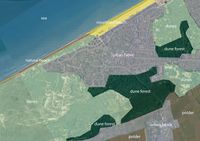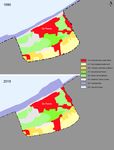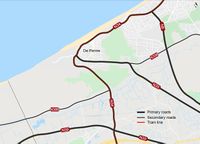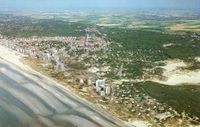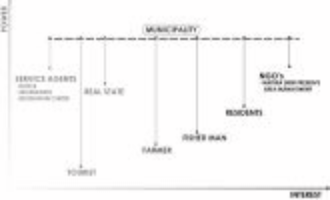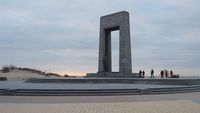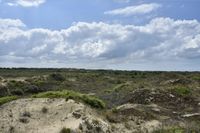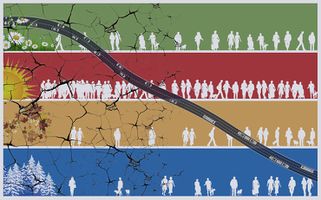COLAND Case Study 2020 - De Panne
>>>back to working groups overview
Rationale
A tourist target area with an extremely floating population, with high movement during the balnear season and almost a desert during the cold season. Tourism can be extremely demanding on the land and coast even more in this particular area that is surrounded by Natura 2000 protected areas. Maintaining and protecting the natural landscape while tackling the need of assuring that the appeal for the tourist continues, considering a possibility of extending the tourism season through the year avoiding desertification and keeping some constant income flow and finally approaching the car issue that is quite intense in this area.
Location and scope
You can edit this map with the map editor
A Landscape System Analysis
A.1 Landscape layers and their system context
Geomorphology, landscape units and coastal typology
Geomorphology: De Panne coastline consists of broad gently sloping sandy beaches with rows of dunes, former mudflats and salt marshes behind the dunes has been turned into polders. On the North Sea shallow continental shelf the Flemish Banks sandbanks occur. The natural beach sediments are mostly fine to medium size quartz grains. The Dunes consist of a mosaic of bare sand areas, dry, moist and wet grassland, shrub and initial dune forest.
Evolution: After the melting of the North European Ice Cap the sea level started to rise (10 000 years ago) and regularly flooded flat areas sheltered by the coastal barrier. Holocene sand and clay deposited on tidal flats formed the dunes. Ongoing flooding triggered the formation of base peat where again sediments were deposited. This pattern reoccurred several times and formed the old dunes. About 3000 years ago a new dune chain was formed and old dunes disappeared.
Drivers of Change: Natural interaction between the beach and the coastal dunes has been disrupted by several centuries of anthropogenic activities, the natural evolution of the coastline would be long term erosion and landward retreat. Marine processes - water level and waves erode dune toes, almost every winter sand is washed away and shoreline decreased. Regular maintenance nourishments are executed by the Coastal Division to repair this damage.
Land use
De Panne mostly consists of discontinuous urban fabric and broad-leaved forest integrated with sand dunes. The area is a part of De Westhoek Flemish Nature Reserve (345 ha), which is the only area on the Flemish coast where nearly all dune vegetation is represented in one unbroken dune landscape. The main points of attraction in the area are two artificial breaks in the dunes, which should normally keep the sea at bay, so that the sea water penetrates into the nature reserve at high tide, making the vegetation and wildlife here particularly special.
Settlement in De Panne is quite dense, but gradually decreases as the city organically transitions into moors with low vegetation and sand dunes. Sand dunes and natural protection area limits the expansion of the building area, although there is also some sparse settlement near the beach and right on the border of the sand dunes.
The main infrastructure consists of three main roads that connect De Panne to other districts such as Duinhoek, Oosthoek and Saint-Idesbald. From the south, the area is bordered with another highway that connects it with France. There is also a 64km coastal tram line that goes along the N34, starting in De Panne and extending all the way to Knokke-Heist.
Non-irrigated arable land surrounds De Panne from the south, in the area itself there occurs no agricultural activity due to the moors and sands on the land cover.
In the last 30 years, the land use hasn’t changed, only a minor increase in settlements.
A great driving force in the area is tourism, as the beach area and Plopsaland De Panne theme park may be the main attraction, the De Westhoek natural reserve also plays an important role with its rich Flora, complemented by rare Fauna that might attract nature enthusiasts.
Severe climate changes and the sea level rise provoque an intensification of the coastal erosion and flood occurrences along all the Belgian coastline. These changes may force mass migration towards the interior since the coastline would not be suitable for the actual human activities.
Green/blue infrastructure
The study area includes Natura 2000 birds and habitats directive sites which is a part of both the green and blue infrastructure. As the protected area is quite distributed with different peculiar landscape elements, the line between green corridor and blue infrastructure is interlacing and merging together.
The major green and blue infrastructure elements are moors and heathland, sparse forest area around the centre and sand dunes. The sea is a part of blue infrastructure along with dunes and ditches in between as they contribute to the water management of De Panne. Changes could occur in the green infrastructure as the building area may expand in the future. As most of the area is protected (Natuurreservaat de Westhoek), including the sand dunes, human activity is probably not a force of change. Due to climate changes the sand dunes and surroundings will most likely be flooded in the future, which is currently managed through the dunes on the south of the city. The area is also surrounded by the mixed agricultural fields. It is a more less organized kind of farm land and animal breeding area, with almost none industrial zones.
In addition to the the preserve areas and the sea, the inner city is integrated with small patches of green pocket spaces which gives relatively enough balance between the built urban setup and the natural environment.
Actors and stakeholders
De Panne is a municipality with 10.153 citizens (NIS, 2007). It is known for its famous route called ‘Erfgoed wandeling’ (Heritage walking), Museum of Oceanic Coast and many sport activities designed for seniors. The unpredictable and dynamic nature of the De Panne coastal area requires adaptable and straightforward basic leadership that grasp a diversity of knowledge and value. Thus stakeholder involvement in the environmental decision-making has been progressively looked for and embedded into national and international policy. So the involved stakeholders concerned with the national agencies through cross-ministerial units, research institutes, coastal user-groups including the tourism industry, coastal residents, local fishers, farmers, developers, sand mining companies, CBOs (Community Based Organisation) and NGOs (Non Governamental Organisation) will be involved at all stages of the project. These stakeholders will be involved and also the beneficiaries of the project.
Sacred spaces and heritage
Cultural heritage - Leopold I Monument
Leopold I memorial is designed by architect Victor Martiny and sculpted by René Cliquet. This monument made of Belgian bluestone and bronze in 1958 is located by sea opposite the Leopold I esplanade.
Leopold I (16 December 1790 – 10 December 1865) was a German prince who became the first King of the Belgians. 17 July 1831, the day that he first entered to independent Belgia in De Panne is commemorated annually as Belgian National Day. He was offered the position of king because of his diplomatic connections with royal houses across Europe. He reigned 34 years during which he encouraged economic modernisation, the creation of Belgium's first railway in 1835 and subsequent industrialisation. His diplomatic action helped to avoid the spread of the Revolutions of 1848 into Belgium and even slightly expand the monarch's powers during his reign.
Military heritage - Belgian Military Cemetery De Panne
The military graveyard is located close by the civil burial ground in De Panne. Altogether the site contains around 3370 Belgian war setbacks. De Panne is along these lines the biggest of all Belgian military burial grounds. It was started by battling units during the First World War. Afterward, graves from various smaller internment destinations in the Westhoek were moved here.
Architectural heritage - Dumont Quarter
The Dumont Quarter is an architectural heritage created between the late 19th and early 20th century under the direction of Belgian architect Albert Dumont. His eldest son Alexis Dumont is co-designer of many buildings and also drew up the plan of the “new De Panne” in 1902-1904.
This district has a unique construction plan with villas built in the style of rural cottages on top of the dunes with the respect for its existing surrounding environment. More modern villas were added later on. The Dumont Quarter has been protected since 1995. A memorial created by Alexis Dumont and Jules Lagae was erected in the district in 1926 for Albert Dumont.
Natural heritage - The Westhoek dunes
The Westhoek dunes are part of 354 ha nature reserve right next to French border. The Westhoek dunes belong to the largest contiguous dune area of the Flemish coast and are protected as landscapes because of archeological and historical value. Area is the oldest Flemish state nature reserve, being under protection since 1935 and 1957. Dunes are characterized by the typical flora and fauna of moist hay and meadows. Also it is possible to observe the dynamic process of dune formation at the various stages of development and dune landscapes with a very different age, shape and vegetation.
Visual appearance and landscape narrative
As De Panne is a coastal town, strong visual elements here are sea, sand (as beach and as dunes) and cottage style buildings. These elements are related with several layers of narratives providing food, shelter and amusement for local and visitors over the years.
Narrative of fisheries
De Panne was founded in 1783, when Austrian branch of the Habsburg Monarchy ruled the Southern Netherlands. Emperor Joseph II wanted to stimulate the inshore fisheries and agreed to erect a small fishing settlement in Adinkerke municipality. Two years after the foundation 26 households were counted in De Panne. The number of small fisheries steadily grew and flourished from the middle of the 19th century on. They were mostly herring fisheries and used specific vessels which were moored on the beach. Several small fish smokehouses were also present in the village. A wealthy landowner Pierre Bortier (1805-1879) who strongly believed that agriculture and fisheries were the crucial basis for a prosperous society, encouraged the fishermen of De Panne to take ownership of their own fishing vessels. That was one of the reasons the fisheries sector was prospered and De Panne was the second most important Belgian fishers community (after Ostend) during the second half of the 19th century. In 1903 there were 2050 inhabitants and 88 fishing vessels. But De Panne had no harbour, and although several plans were made over the years to construct a harbour, none of these projects succeeded. Due to modernisation and increase in scale the fisheries sector relocated to coastal towns with harbours after WWI and De Panne lost its importance as a fishing village.
File:Edgard_Farasijn.jpg|Edgard Farasijn (1858-1938) painting The Hotel Du Kuursaal in De Panne, before 1877
Narrative of the beach resort
At the end of the 19th century when a beach tourism in Belgium started to become popular De Panne eventually transformed into a larger town than Adinkerke and became independent in 1911. New settlement was designed as a “garden city” to limit the impact on nature. Cottage style, art deco, art nouveau and modernist style villas give De Panne its unique appearance. The idea of healing sea baths came to the coast of Belgium from England. The seaside holiday was very popular amongst upper classes (nobility and young industrialists) for both the cure and for social amusement. After the WWI number of seaside visitors increases, as sunbathing also becomes popular. With the introduction of paid leave the elitist nature of coastal tourism gradually disappeared. New hotels, bungalows, villas and entertainment were built and the local population focused more and more on tourism and the associated secondary activities. After the Second World War, tourism expanded on a large scale, the secondary road network and habitation is expanding considerably causing dune fragmentation.
Narrative of freedom
The Municipality of De Panne has played a politically important role throughout history. According to the legend it was De Panne where king Leopold I stepped on to the shore of Belgium on 17 July 1831 and became its first king. During the First World War when Germany occupied Belgium, De Panne was the last free corner called "the actual capital of unoccupied Belgium". King Albert I resided there during the war and became incredibly popular because he stayed with his soldiers. This King Knight was also popular abroad as to stand against German ultimatum. During the war many refugees and allied soldiers gathered into De Panne, king family and dignities were established into the villas. All social, cultural and charitable works, also newspapers were published and printed in town, and hospitals were established to take care of wounded. In the second half of the war De Panne municipality was heavily bombarded, and the king left the town. More than half of the buildings were damaged and the population was very sparse but De Panne recovered and became a popular summer resort. Although Belgia remained neutral in the Second World War it was once again occupied by Germany. Many military buildings are still remaining from that time when German reserve troops were accommodating in De Panne. Field batteries situated on dunes of Cabour, and later on the beach of De Panne. Some bomb craters are still visible in the dunes from heavy bombing of 1944. Liberation with the help of Czechoslovakian soldiers is honored with several monuments and museums around and in De Panne.
- Your case character1.jpg
add a caption
- Your case character2.jpg
add a caption
- Your case character3.jpg
add a caption
A.2 Summary of your landscape system analysis and your development targets
Goal 6: Clean water and sanitation - even though there is not much change in the population, the demand for proper sanitation and clean water increases with the seasonal flow of tourists. The wastewater treatment and disposal mechanisms should be given focus for better sustainable development of the site and maintaining the natural environment.
Goal 7: Affordable and clean energy - the energy resource should be better suited with the efficient and sustainable development strategies. Renewable and environmentally friendly sources of energy need to be integrated in the area. Solar energy, which is already tried to be implemented in the area, and wind energy could be a good start to apply as a source of energy.
Goal 8: Decent work and Economic growth - the young population in the area is noticed to migrate from the area to bigger cities and other countries. The area is basically known for its tourism activity. Though that is a good economic source, the place needs to develop enough work opportunities and economic development to sustain and further develop the city.
Goal 12: Responsible consumption and production - the resource in the area, including the groundwater and the measure tourist attraction center of the coastal area, needs to be properly utilised and maintained. Over consumption of the resources will not only degrade the natural balance but also kill the whole economic and social activity of the area.
Goal 13: Climate action - the area is relatively less harming to the climate, nonetheless activities that are engaged in the area need to keep improving previous impacts and counter balance the upcoming climate changes which will eventually influence the coast and the whole ecosystem of the area.
Goal 14: Life below water - since the area is on the coast most activity done in the place influences the life system below the sea. The sea is part of the Natura 2000 preserve areas, which helps it to be impacted by human activities. But in addition to it the water and coastal recreation and any economic activities need to be considerate of the life cycle underwater.
Goal 15: Life on Land - there are different habitat and bird preserve areas on the site. The place is integrated with complex biosystems, including forest, sand dunes, coast, sea, grassland and also the urban space within it. This mixed up life on land should be well maintained and the environment should be habitable for all the life within it.
Goal 17: Partnership - the area is an ideal example where different stakeholders, the government, residents, interested investors and additional economic and social participants, are participating in the changing progress. A good partnership and collaboration between all the different groups is required to come up with a sustainable development in the area.
In the study area, unlike most places, population growth and urbanisation are some how controlled and has less impact. Nonetheless the economic stability and the different change in the natural phenomena are major influential forces driving the change. Climate change and the change in the coastal interface of the city which is the major image of the place creates a major influence in the recent development of the area. Following those forces the activities in human and natural activities which led to changes in the area pressures the situation in the city. Pollution, sedimentation process especially in the coastal area and the habitat loss are major identified pressures in the place. The current lack of variety of job opportunity and social structure together with quality of water and waste waste production are further intrigued with upcoming pressures in the area. The resulting consequences of those driving forces results both social and natural changes. Major natural changes resulted are rise in the water level, loss of biodiversity and erosion on the coastal are. Whereas the the people, especially the youth migrating to bigger cities and resulting dormant state of the place in some seasons are the sociological impacts. The actions done to counter balance these major impacts are the most sensitive parts on the current time we need to focus. In order to come up with a more sustainable development the good strategic counter acts are required. Beach nourishing, more diverse seasonal activities, preservation policies, public transport, recycling and use of renewable energy resources are considered responsive measures. Study area, unlike most places, population growth and urbanisation are some how controlled and has less impact. Nonetheless the economic stability and the different change in the natural phenomena are major influential forces driving the change. Climate change and the change in the coastal interface of the city which is the major image of the place creates a major influence in the recent development of the area. Following those forces the activities in human and natural activities which led to changes in the area pressures the situation in the city. Pollution, sedimentation process especially in the coastal area and the habitat loss are major identified pressures in the place. The current lack of variety of job opportunity and social structure together with quality of water and waste waste production are further intrigued with upcoming pressures in the area. The resulting consequences of those driving forces results both social and natural changes. Major natural changes resulted are rise in the water level, loss of biodiversity and erosion on the coastal are. Whereas the the people, especially the youth migrating to bigger cities and resulting dormant state of the place in some seasons are the sociological impacts. The actions done to counter balance these major impacts are the most sensitive parts on the current time we need to focus. In order to come up with a more sustainable development the good strategic counter acts are required. Beach nourishing, more diverse seasonal activities, preservation policies, public transport, recycling and use of renewable energy resources are considered responsive measures.
Key words:landscape fragmentation, sustainable transportation, seasonal activity and recreation and climate change.
In this city where tourism is the major economic activity we face the challenge of seasonal fluctuation on activeness of the area which raises an issue in the permanent infrastructure development. Whereas there also exists the need to maintain different landscape areas, of some under protection, and counteract the climate change.
A.3 Theory reflection
In the International level the Guiding Principles for City Climate Action is one of the fundamental documents of the united nation published in 2015 by UN-Habitat. The guiding principle for city climate action planning is basically aimed primarily at city-level actors. They give a typical reference point to nearby authorities and local planning practitioners, just as other stakeholders in urban areas around the world. Together these eight principles are expected to be applied to significant components for the development of coastal areas (de Panne), from preparing to making a plan. (1) The Guiding Principles will be used to guide the development of de panne coastal area and (2) The Guiding Principles will also help with support from academic, private sector, and NGO endorsing partners, as well as the municipalities can be applied to help local climate action planning efforts in the communities.
At European policy document the Integrated Coastal Management was adopted. The focus area could arrive at the suggestions of the Integrated Coastal Management which aims to improve the environmental management, promotes integrated coastal management methods with enhancing the protection of the coastal resources and promoting coastal tourism, reinforce local collaboration in the study area and foster sustainable coastal development: which stimulate an enduring changes are strategies towards progressively sustainable development, to support the populaces of the study area.
In the National policy document the Natura 2000 was used as theory of reflection at the national level which tends to focus on the network of protected region with conservation of biodiversity in terms of ensuring the long haul existence of Europe's most valuable and undermined species and habitats. Also the Natura 2000 divides conservation into types which form the cornerstone of the European Union nature Protection Policy are: (1) The Habitat directive which primary focus is on the protection of wild flora and fauna, particularly threatened or endemic species. (2) The Birds directive is aimed at protecting all wild bird habitats and wild bird species. This implies in the study area because of the natural habitat being rapidly decreasing because of the urban spread and agriculture in the area as well as the migration of species in the area.
A.4 References
http://ec.europa.eu/environment/iczm/index_en.htm
https://unhabitat.org/books/guiding-principles-for-climate-city-planning-action
http://ec.europa.eu/environment/nature/natura2000/index_en.htm
https://www.researchgate.net/publication/230629826_Ecological_restoration_in_Flanders
https://www.un.org/sustainabledevelopment/sustainable-development-goals/
http://www.vliz.be/imisdocs/publications/ocrd/263343.pdf
https://www.belgiancoast.co.uk/en/inspiration/coastal-tram
https://en.wikipedia.org/wiki/Leopold_I_of_Belgium
https://www.monarchie.be/en/royal-family/history/king-leopold-i
https://www.belgiancoast.co.uk/en/do/belgian-military-cemetery-de-panne
https://inventaris.onroerenderfgoed.be/erfgoedobjecten/200974
http://tourism.depanne.be/product/1201/dumont-walking-tour
https://nl.wikipedia.org/wiki/Albert_Dumont
https://inventaris.onroerenderfgoed.be/personen/1980
https://alexisdumont.brussels/nl/catalogus/monument-albert-dumont-albert-dumontlaan-de-panne
https://inventaris.onroerenderfgoed.be/aanduidingsobjecten/10587
https://nl.wikipedia.org/wiki/Natuurreservaat_De_Westhoek
http://www.coastalwiki.org/wiki/Fisheries_in_De_Panne
http://www.xplorengo.com/eng/europe/Belgium/westflanders/depanne/culture.htm
https://depanne.com/en/history.php
https://inventaris.onroerenderfgoed.be/erfgoedobjecten/302416
http://www.xplorengo.com/eng/europe/Belgium/westflanders/depanne/culture.htm
https://inventaris.onroerenderfgoed.be/erfgoedobjecten/213257
https://inventaris.onroerenderfgoed.be/erfgoedobjecten/213256
https://inventaris.onroerenderfgoed.be/erfgoedobjecten/213255
https://inventaris.onroerenderfgoed.be/erfgoedobjecten/306840
https://inventaris.onroerenderfgoed.be/erfgoedobjecten/200969
https://spectator.sme.sk/c/20618600/czechoslovak-soldiers-remembered.html
Phase B: Landscape Evaluation and Assessment
B.1 Assessment Strategy
- Based on the hypothesis derived from your previous landscape systems analysis you are now asked to define the goals for assessing the landscape. Your assessment is the basis for evaluating the landscape status.
- Which elements and phenomena need to be mapped, why and how?
- This a text contribution, max 250 words
B.2 Mapping
- As defined by your assessment strategy you conduct the mapping and present your findings here
- As a minimum, at least three different themes need to be mapped, you may choose more if needed
- Your case your assessment mapping themel.jpg
briefly explain the findings of your mapping
- Your case your assessment mapping theme2.jpg
briefly explain the findings of your mapping
- Your case your assessment mapping theme3.jpg
briefly explain the findings of your mapping
B.3 Problem definition and priority setting
- Give a summary of the major findings of your mapping process, what are the problems/potentials identified?
- Draw a problems/potentials map
- Set priorities for the most relevant issues
- Your case problems potentials map.jpg
add caption here
B.4 Theory reflection
- Please reflect the assessment and evaluation methods used based on at least three readings
- Did you encounter limitations'
- 200 words test contribution
B.5 References
- give a full list of the references you have used for this section
Phase C – Strategy and Master Plan
C.1 Goal Setting
- Define strategic planning objectives based on the evaluation findings
- Link back to your original targets from section one and the Development Goals
- 150 words text contribution
C.2 Spatial Strategy and Transect
- translate your strategic goals into a vision
- develop a spatial translation of your vision
- exemplify your vision in the form of a transect with concrete interventions
- add map(s) and visualizations
- Your case spatial translaton vision.jpg
add caption here
- Your case transect.jpg
add caption here
- Your case transect detail1.jpg
add caption here
- Your case transect detail2.jpg
add caption here
C.3 From Theory of Change to Implementation
- For implementing your vision: Which partnerships are needed? Which governance model is required?
- Who needs to act and how? Draw and explain a change/process model/timeline
- Which resources are needed? On which assets can you build?
- add 150 words text and visuals
- Your case spatial your governance model.jpg
add caption here
- Your case spatial your process model.jpg
add caption here
C.4 References
- give a full list of the references you have used for this section
D. Process Reflection
- Reflect in your intercultural and interdisciplinary team on the outcomes of your study
- Which limitations were you facing?
- What have you learnt from each other?
- What would you do differently next time?
- You can also use diagrams/visuals
- 250 words text



